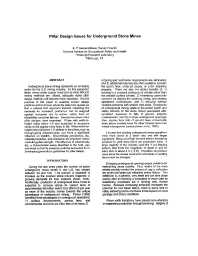Mining Publication: Pillar Design Issues for Underground Stone Mines
Original creation date: January 1999
Underground stone mining represents an emerging sector for the U.S. mining industry. As this expansion takes mines under deeper cover and as more efficient mining methods are utilized, adequate stone pillar design methods will become more important. It is the purpose of this paper to examine current design practices and to discuss issues for safe mine layouts so that a rational first approach towards balancing the demands for increased production can be weighed against increased risk to worker safety from rib instabilities and pillar failures. Seventy-two stone mine pillar designs were examined. Pillars with width-to-height ratios below 1.5 and subjected to excessive stress levels appear more likely to fail. When width-to-height ratios fall below 1.0, defects in the pillars, such as through-going discontinuities, can have a significant influence on stability. Discontinuity persistence, dip, material properties, and orientation are important factors controlling pillar strength. The influence of discontinuity dip, a characteristic easily identified in the field, was examined so that its presence could be accounted for in developing generalized guidelines for pillar design.
Authors: AT Iannacchione
Conference Paper - January 1999
NIOSHTIC2 Number: 20024913
Proceedings of the 18th International Conference on Ground Control in Mining, Peng SS, Mark C, eds.,Morgantown, WV: West Virginia University, 1999 Jan; :271-281
See Also
- Analysis of Pillar Design Practices and Techniques for U.S. Limestone Mines
- A Computer Software Program that Estimates Air Quantity Requirements in Large Opening Stone Mines
- Effects of Weak Bands on Pillar Stability in Stone Mines: Field Observations and Numerical Model Assessment
- Pillar and Roof Span Design in Stone Mines
- Pillar Stability Issues Based on a Survey of Pillar Performance in Underground Limestone Mines
- Pillar Strength and Design Methodology for Stone Mines
- Roof Span Design for Underground Stone Mines
- Technology News 516 - ARMPS-HWM: New Software for Sizing Pillars for Highwall Mining
- Underground Stone Mine Pillar Design in Challenging Conditions
- Using the Coal Mine Roof Rating (CMRR) to Assess Roof Stability in U.S. Coal Mines
- Page last reviewed: 9/21/2012
- Page last updated: 9/21/2012
- Content source: National Institute for Occupational Safety and Health, Mining Program


 ShareCompartir
ShareCompartir
